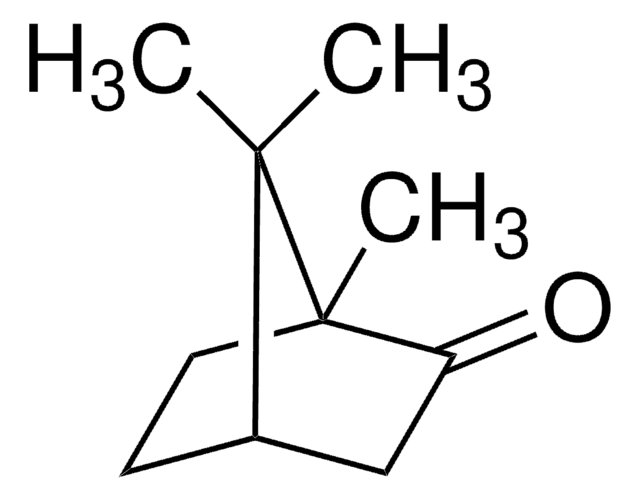PHR1119
D-Camphor
Pharmaceutical Secondary Standard; Certified Reference Material
Sinonimo/i:
2-Bornanone, 2-Camphanone
About This Item
Prodotti consigliati
Grado
certified reference material
pharmaceutical secondary standard
Livello qualitativo
agenzia
traceable to Ph. Eur. C0405000
traceable to USP 1087508
Densità del vapore
5.24 (vs air)
Tensione di vapore
4 mmHg ( 70 °C)
Famiglia di API
camphor
CdA
current certificate can be downloaded
Temp. autoaccensione
870 °F
Limite di esplosione
3.5 %
tecniche
HPLC: suitable
gas chromatography (GC): suitable
Punto di fusione
178-182 °C (lit.)
applicazioni
pharmaceutical (small molecule)
Formato
neat
Temperatura di conservazione
2-8°C
Stringa SMILE
CC1(C)[C@@H]2CC[C@@]1(C)C(=O)C2
InChI
1S/C10H16O/c1-9(2)7-4-5-10(9,3)8(11)6-7/h7H,4-6H2,1-3H3/t7-,10+/m1/s1
DSSYKIVIOFKYAU-XCBNKYQSSA-N
Cerchi prodotti simili? Visita Guida al confronto tra prodotti
Descrizione generale
Applicazioni
Risultati analitici
Altre note
Nota a piè di pagina
Prodotti correlati
Avvertenze
Danger
Indicazioni di pericolo
Classi di pericolo
Acute Tox. 4 Inhalation - Eye Dam. 1 - Flam. Sol. 2 - Skin Irrit. 2 - STOT SE 2 Inhalation
Organi bersaglio
Lungs
Codice della classe di stoccaggio
4.1B - Flammable solid hazardous materials
Classe di pericolosità dell'acqua (WGK)
WGK 1
Punto d’infiammabilità (°F)
147.2 °F - closed cup
Punto d’infiammabilità (°C)
64 °C - closed cup
Choose from one of the most recent versions:
Possiedi già questo prodotto?
I documenti relativi ai prodotti acquistati recentemente sono disponibili nell’Archivio dei documenti.
I clienti hanno visto anche
Il team dei nostri ricercatori vanta grande esperienza in tutte le aree della ricerca quali Life Science, scienza dei materiali, sintesi chimica, cromatografia, discipline analitiche, ecc..
Contatta l'Assistenza Tecnica.












